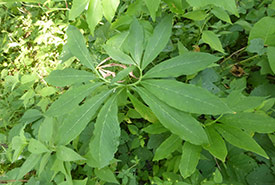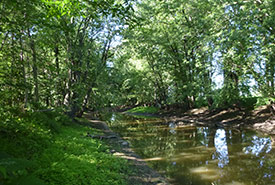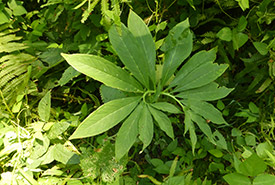NCC: Land Lines – An unexpected discovery: green dragons!

Green dragon on the Gasser Farm property, QC (Photo by NCC)
On September 1, 2020, toward the end of a work day in the Lake Champlain area and finding that I had an extra couple of hours, I decided to take advantage of the dry season. I wanted to try my luck at crossing the channel of the Pike River to reach an island acquired by the Nature Conservancy of Canada (NCC) in 2019 — the Gasser Farm property — where I had been tasked with doing a floristic inventory.

Crossing a channel of the Pike River to get to the Gasser Farm property (on the right side of this picture) (Photo by NCC)
Taking advantage of the time alone and not wanting to miss anything, I walked quietly around the small island, finding young butternut trees and western hackberry trees. Reaching an area that was a bit trickier to access to continue my inventory, I stepped over reed canary grass intertwined with American groundnut. Keeping my eyes on the ground, I took care to avoid touching Canada nettle and poison ivy while trying to keep my footing on the debris brought by the flood,s which are common in the area. Suddenly I spotted a first shoot of green dragon. Wow! What a delightful plant; one of a kind. But what was it doing here? I had never seen it in this region!
Green dragon, a perennial wildflower that measures from five to 110 centimetres tall, is also found in this area. It is listed as threatened in Quebec and is assessed as special concern by the Committee on the Status of Endangered Wildlife in Canada. Green dragon is usually found in island and riparian habitats along the St. Lawrence River. There is only one other known location outside the river region — in the Chambly basin. As I continued to explore its habitat, I found more individuals, numbering 50 in total, both large and small.

Green dragon is listed as threatened in Quebec and is assessed as special concern by the Committee on the Status of Endangered Wildlife in Canada. (Photo by NCC)
Later, back in front of the computer, I was congratulated on my find by a community of experts, including Quebec’s best botanists. They all seemed to agree that it was a new occurrence and that it was a significant discovery for this species. Fortunately, this population is now protected!
In order to protect green dragon, NCC has put in place certain actions to control invasive species, like garlic mustard, that threaten its habitat. A multi-year monitoring of the green dragon population is also being planned, as this discovery considerably expands the species’ known range. In fact, the nearest other green dragons, those in the Chambly Basin, raise the possibility that other populations might exist along Pike River or even in other areas where we would not expect to find them!
Since that day that I stumbled upon the green dragon population on the Gasser Farm property, I’ve been back again this year to remove the garlic mustard and finish the inventory and am happy to report it’s still thriving. Some green dragons have been seen in another place on the island and they were in good shape. The good news is this population is somewhat protected by itself since it is on an island that is difficult to access and by the fact that the island is covered in poison ivy. Bad news though; I had come into contact with poison ivy on my skin even though I was wearing protection.




